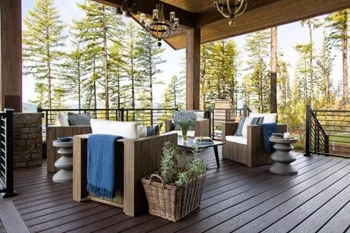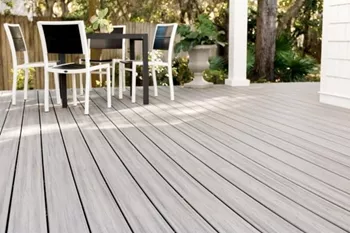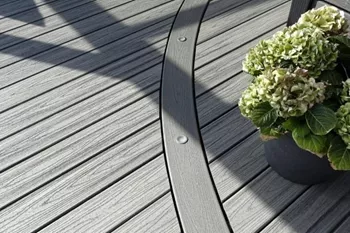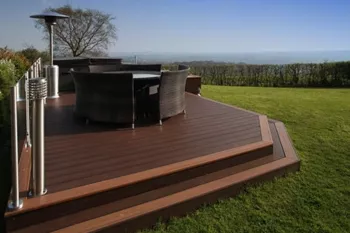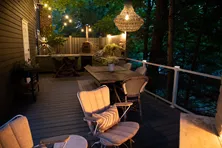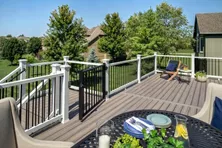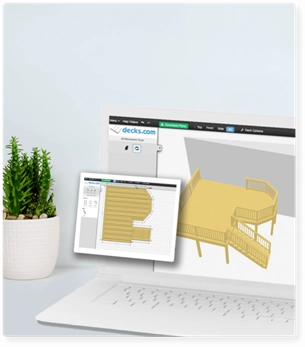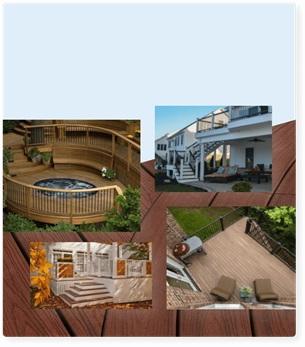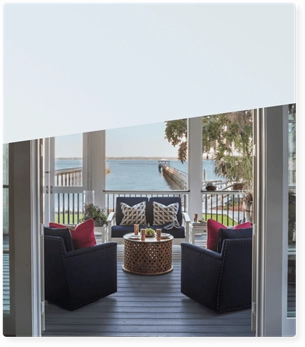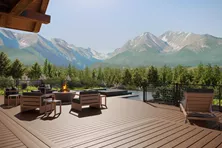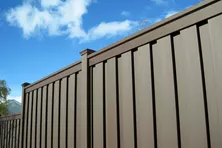Selecting The Best Composite Decking Color For Your Home
With so many composite decking color options, there isn’t a “best choice” -- but rather, it’s about finding the color that works best for you. From tonal variations to solid shades that can match any taste, decor, and environment, homeowners have an assortment of decking colors to choose from.
When making your choice, you want to pick the decking that’s going to look best with your home and that you will love for years to come. Follow these simple tips to make selecting a decking color fun and easy.
What Composite Deck Colors are Available?
Browsing through all (and we do mean all) of the composite decking colors available to you can present you with a number of questions when it’s time to make your choice: “Is traditional brown decking a good fit? Or will modern grey with streaking look better?” “Do I want the cooler-toned brown or the warmer-toned shade?”
To help make choosing a color for your deck easier, think about shades you naturally gravitate toward. This can be a springboard for narrowing your choices. Once you have a short-list of colors you love, you can further whittle your selections by seeing how well they pair with the colors of your home’s exterior, trim, and the environment surrounding your deck.
There are three basic color families of composite decking offered by most retailers. However, it’s the tonal variations among this trio of composite decking color families that make each one distinct.
These color families are based around shades of:
- Grey - ranging from light grey to deep charcoal
- Brown - spanning from the warmest browns to cooler shades of tan
- Red - with cooler undertones or fiery warmer tones
If you think back to school, you might recall learning about the warm and cold undertones in colors. For example, colors with red or orange undertones are warmer than those with blue undertones, which are categorized as cooler colors. Think of the reds and oranges of fall leaves versus the cool tones of ocean blues. It’s these undertones that will help your deck look “warm” or “cool” based on when the sun hits them.
Depending on whether you choose grey decking with lightly-weathered driftwood look or a rich, warm brown, it makes sense to think about your environment and the way the sun hits the area where you’re building your deck. (We’ll talk more about the role of home and environment below.)
You may also want to think about combining colors with your composite deck boards. If you have superior DIY skills or you’ve hired a professional contractor, you can use two or more colors to create a gorgeous herringbone pattern or another style of design that weaves together multiple hues.
Things to Consider When Choosing a Deck Color
When you’re choosing your deck color or colors, consider both your climate and the exterior of your home. If your home exterior is darker or if you live in a wooded area, it may make sense to choose decking colors in the medium to dark range so your deck will blend well with your home and surroundings.
Your location and geographic conditions may also play a role in picking the best color for your deck. If you live in the Pacific Northwest, a rich red or brown deck in your backyard will look gorgeous in the summer sun. However, if you have a beachfront home in sunny Florida, cool grey decking boards will pair beautifully against the blue sky and serve a dual purpose by deflecting the hot summer sun.
Your location and geographic conditions may also play a role in picking the best color for your deck. If you live in the Pacific Northwest, a rich red or brown deck in your backyard will look gorgeous in the summer sun. However, if you have a beachfront home in sunny Florida, cool grey decking boards will pair beautifully against the blue sky and serve a dual purpose by deflecting the hot summer sun.
If you have a deck that attaches to your home, you may also want to consider your interior flooring. Choosing a decking color similar to your carpeted or hardwood floors will make for a more cohesive look and a smoother transition from your interior to your deck.
Do You Live In a Sunny Area?
Living in a region that gets a lot of year-round sun can also influence the colors you choose for your composite decking. Places with sunny climates (like Florida and Arizona) have more sunny days and warmer year-round temperatures than New England states or the Midwest. Not only is there more sun, but the light is different in these parts of the country due to the position of the sun.
The colors you choose can help your composite deck stay cooler or warmer, helping keep you more comfortable while you’re enjoying it. Light colors, such as Island Mist grey composite decking board, have the appearance of driftwood and attract less sun than a darker color.
Conversely, people who live in the Northwest, Northeast, and Midwest, can worry less about attracting heat and can look to rich browns or red shades for a warmer feel, like deep, red Lava Rock.
Consider the Color Of Your House
Besides climate, another factor to consider is the color of your house. A little contrast between your decking colors and your home goes a long way when it comes to style and curb appeal. When deciding between the three composite decking color families, there are a few design guidelines to help you decide which goes best with the color of your house and surroundings.
- Grey decking goes well with white, blue, grey, and red homes -- particularly in sunny areas.
- Brown composite decking colors will go with almost any house color.
- Red can work well with a variety of home colors and textures, including stucco or brick facades.
The key is to have just enough contrast with your home that your deck stands out as the perfect place to relax.
Composite Deck Railing Colors
One of the most common questions around choosing colors is whether deck railings should be a different color from the house or deck itself. There is no right or wrong answer. Rather, it depends on your home, your taste, the environment, and how elaborate you want your deck to be. Choosing railings that are a similar shade as your deck will keep it cohesive and give it a relaxed, monochromatic look. On the flip side, choosing a contrasting railing color will make it stand out more and have a slightly more ornate feel.
What about color? A white deck railing looks great in coastal areas and places that get a lot of sun. White railings also work well with most house colors and can be paired with nearly any decking color. A black or brown railing works well with brick houses, homes with vinyl siding, and houses with a rustic aesthetic.
These aren’t your only options, however. You can also choose to have your deck railing match your window frames for a striking contrast or opt to keep your railings in the same color family as your home’s exterior for a seamless transition.
Order Deck Samples to See in Person
Still wondering what deck color is right for you? This Color Selector can help you choose the ideal color for you, your deck, and your home.
Once you’ve narrowed down your list to a few different colors, you can request a sample to be mailed to you so you can see the color and quality up close. You can see how the light will hit the composite decking throughout the day and get a sense of what it will look like at your home.
From sipping your morning coffee to hosting family gatherings, you will make so many memories on your new deck. Choosing the best color for your composite deck is a big decision, but it can be fun if you follow these easy guidelines.
Decking Patterns
Step into the world of deck design and push the limits of your imagination with our collection of deck patterns and ideas. From classic single-width and diagonal layouts to intricate herringbone and chevron designs, we illustrate the wide range of patterns that will unlock your creativity.
Hanging String Lights
Hanging string lights on a deck is a great way to enjoy summer nights. Learn how easy it is to hang any type of string lights on a deck with Decks.com.
Small Deck Ideas
With the right setup and décor, you can transform a small deck into a perfect outdoor oasis. Get inspired with these design ideas for small decks at Decks.com.
IRC Code Requirements For Decks
Residential properties have certain code requirements that must be met before building a deck known as the IRC. Learn more about IRC building codes for decks at Decks.com!
Best Budget Friendly Decking Ideas
Get straightforward guidance on building a budget-friendly deck. Learn how to set a realistic budget, choose cost-effective materials, and design strategies to keep expenses from getting out of hand.
IBC Requirements For Decks
The International Building Code (IBC) regulates deck additions attached to commercial buildings. Learn how IBC requirements may affect your project at Decks.com.
More Helpful Resources
Explore Articles by Topic

Footings
Information related to installing frost footings for decks

Framing
Learn structural framing methods

Decking
Learn about wood and composite decking materials

Stairs
An in-depth look at the complex issue of how to build stairs

Railings
How to install guardrails and handrails to meet IRC code

Features
An overview on water drainage, benches, planters and lights

Design
The basics of deck design

Planning
Learn about permits and working with contractors

Porches & Patios
Build a covered deck to enjoy all seasons

Ledger
Proper attachment techniques

Care
Maintain your deck to maintain your investment

Materials
An overview on water drainage, benches, planters and lights
Pool Deck Ideas on a Budget
A stylish poolside retreat doesn't have to come with an over-the-top price tag. Allow us to show you some easy and innovative ways to build a stunning pool deck that won't empty your wallet.
The Best Deck Styles for Every Part of the Country
Deck taste and styles in the US differ across the country. Check out these popular looks from every region.
10 Fence Ideas to Add Privacy and Style to Your Yard
10 Fence Ideas to Add Privacy and Style to Your Yard
How to Grade Your Yard
Master the art of yard grading! From choosing the right slope to understanding the costs, this guide covers everything you need to achieve a properly graded yard that protects your home and enhances your landscape.
Best Budget Friendly Decking Ideas
Get straightforward guidance on building a budget-friendly deck. Learn how to set a realistic budget, choose cost-effective materials, and design strategies to keep expenses from getting out of hand.
IRC Code Requirements For Decks
Residential properties have certain code requirements that must be met before building a deck known as the IRC. Learn more about IRC building codes for decks at Decks.com!
Explore Articles by Topic

Footings
Information related to installing frost footings for decks

Framing
Learn structural framing methods

Decking
Learn about wood and composite decking materials

Stairs
An in-depth look at the complex issue of how to build stairs

Railings
How to install guardrails and handrails to meet IRC code

Features
An overview on water drainage, benches, planters and lights

Design
The basics of deck design

Planning
Learn about permits and working with contractors

Porches & Patios
Build a covered deck to enjoy all seasons

Ledger
Proper attachment techniques

Care
Maintain your deck to maintain your investment

Materials
An overview on water drainage, benches, planters and lights




